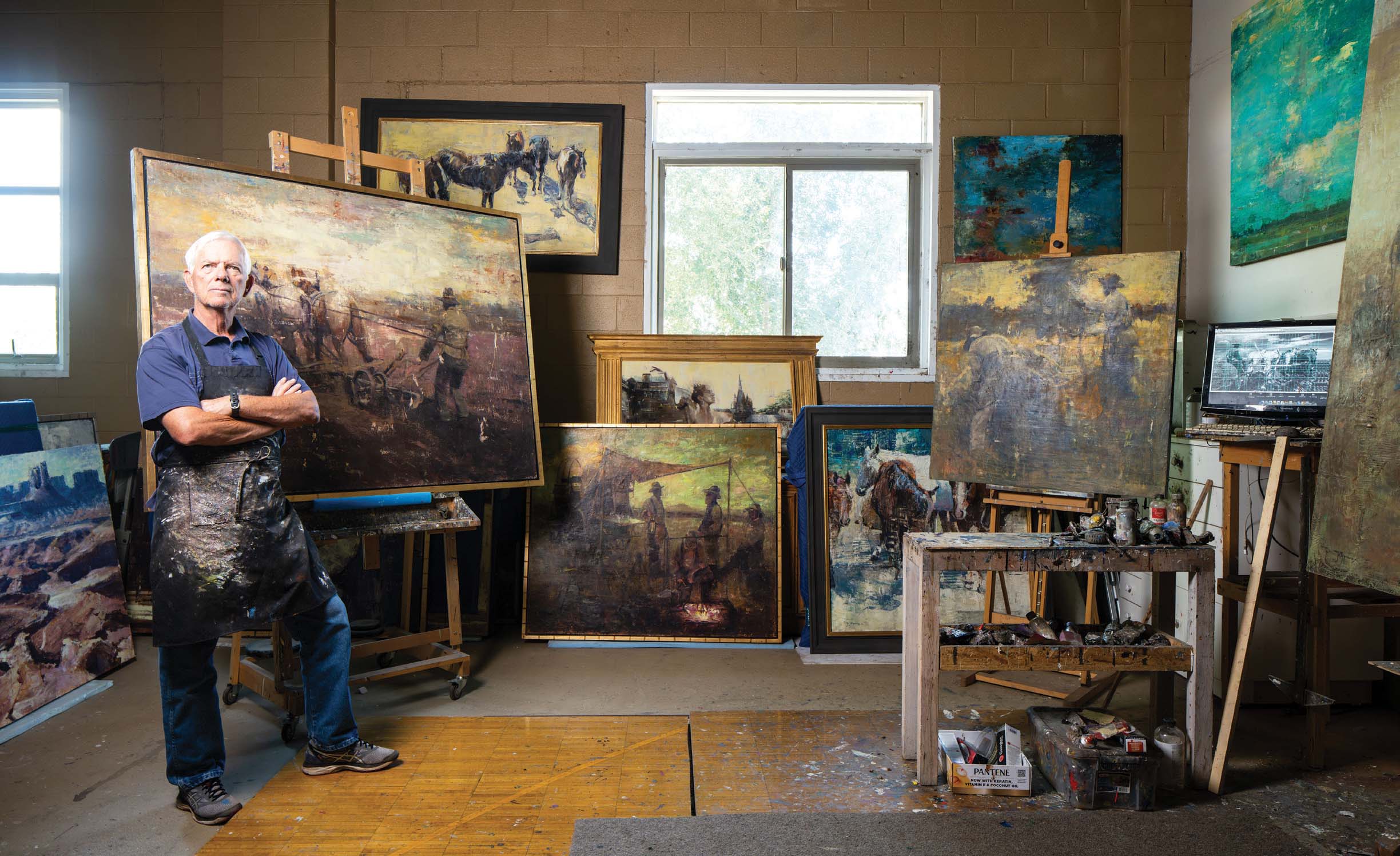
31 Oct IN THE STUDIO: ARTISTIC EVOLUTION IN THE HEART OF DENVER
Eight years ago, Denver, Colorado-based artist Robert Spooner relocated from a 200-square-foot studio to a 700-square-foot space, and his paintings reflected the expansion. The new studio allowed Spooner to progress to larger works and create his process of “extreme indirect painting.”
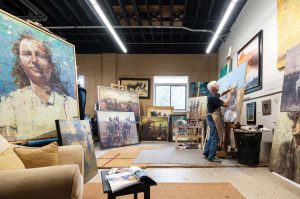
Spooner describes his creative process as “additive and destructive.” He uses various tools and materials, including Venetian plaster, in his artworks.
Spooner’s studio is one of more than 70 creative spaces in Denver’s 38,000-square-foot artists’ complex, Prism Workspaces. “This had been a woodworking studio, and there was dust everywhere,” says Spooner, who carries on the craft, building the crate panel painting surfaces and frames for his artworks. He even constructed a wooden easel. In a corner, lengths of molding lean near organized shelves with assorted glues, stains, hardware, and hand tools. The ceilings are high. The windows face west, and though the painter works in his studio seven days a week in winter, he’s ready to call it a day by the time the late afternoon sun angles in to glare off his works-in-progress. For comfort, he added sections of a vintage wooden basketball court as flooring to soften the uncompromising concrete below. “That floor has saved my back,” says Spooner, “because a basketball court has some spring to it.”
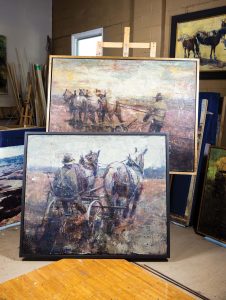
American history inspires the artist. “I get an emotional connection to who has come before us,” he says, “those who helped develop the land of America.”

Spooner’s technique adds texture and depth, as seen in this work-in-progress.
Prism Workspaces provides studios to artists forced to move due to Denver’s widespread development. “We have a lot of artists who were kicked out of their studio environments, and we’re 100 percent full,” says Linda Strammiello, one of the owners of Prism Workspaces. Artists in the complex benefit from 24-7 access, a loading dock, and lease rates that include utilities and Wi-Fi. The space also hosts open studio nights twice annually. “We have a friendly community,” says Strammiello, “and everyone is excited to meet artists in their studios.”
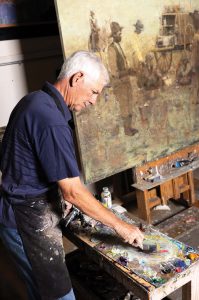
In his Denver, Colorado, studio, Spooner adds paint to his palette while working on a piece in his American Heritage series. The artist is known for using muted colors and imbuing his work with texture.
Spooner says he enjoys the open studio events and is also happy to meet collectors by appointment. He prefers to sell his work directly rather than through galleries, and he does not accept many commissions because he is admittedly headstrong about the integrity of his paintings. “I’m painting for my legacy,” he says. “I like to know who’s acquiring my work.”
Spooner’s studio is full of paintings: some mounted on walls, others leaning against one another four or five deep throughout the space. At first glance, the compelling texture is most evident in Spooner’s oeuvre. With paint and plaster, distressed surfaces, and his typically muted palette, the artist’s paintings call to mind the frescoes of Renaissance Italy, except that his subject matter, for the most part, draws from the American West. He has painted rodeo scenes, portraits of Gene Autry and Roy Rogers, herds of horses, and cowboys wrangling cattle or gathered near a chuckwagon for chow time at dusk.
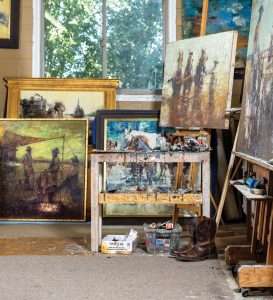
Spooner’s studio features high ceilings and natural light and is located inside Prism Workspaces, a 38,000-square-foot building with more than 70 artists’ studios. Moving into this 700-square-foot space allowed the painter to create larger works of art.
The painter is currently prioritizing his American Heritage series, which celebrates unsung working-class people who labored to develop the U.S. One painting depicts a Black family picking cotton in Arkansas; the little girl’s searing gaze speaks of rebellion. Others portray men in bib overalls and cowboy hats working fields with antique farm implements and teams of horses. “I’m not painting little girls with cowboy hats and suckers. I’m not painting a new John Deere tractor. I’m not trying to depict a modern cowgirl in bright colors. I’m trying to create something more timeless from a period anywhere in the last 100 years,” says Spooner. “I’m not a cowboy, but I grew up in New Mexico with farms all around. My grandfather moved in a wagon from San Marcus, Texas, into Roswell, New Mexico. I became fascinated with the Farm Security Administration’s photos of the 1930s. I lean toward those people as true Western characters.”
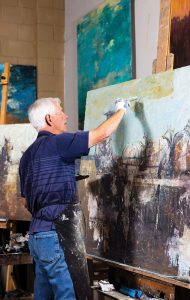
In addition to paintbrushes, Spooner uses a variety of other tools. He typically lays down 15 to 20 layers for each of his paintings. “I don’t consider it talent; I consider it determination,” he says. “I have to find my own path through each piece.”
Spooner paints the American West with a sense of reverence. In addition to texture, the paintings possess emotional depth. While contemporary, the art bears a sense of the past due to the nicks and scuffs in the paint — an aging that suggests the hard labor of farmers, ranchers, and field workers. “I don’t want it to look contemporary,” says Spooner.
“I’ve watched Robert Spooner’s art journey for almost 30 years,” says Quang Ho, a celebrated Denver-based painter. “It’s great to follow his search and growth as an artist, which is leading him now to an exploration of texture and paint in his recent works — very evocative and exciting. The paintings go beyond the subject matter. He is finding his own voice.”
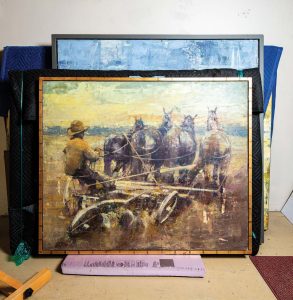
Photographs from the 1930s taken by the Farm Security Administration inspire Spooner’s appreciation of rural American history. The artist is prioritizing his American Heritage series, which celebrates the working-class people who helped develop the U.S.
Spooner is soft-spoken. Like the farmers and ranchers he paints, he’s humbly committed to hands-on work. On the studio walls marked with his colorful handprints, Spooner wrote inspirational messages in indelible marker: “It isn’t talent, just ‘obsessive curiosity,’” and “It’s not the destination, it’s the journey.”
Spooner’s artistic journey began in fifth grade when he enjoyed being dismissed from class to paint the backdrops for school plays. His current large-scale work represents a full circle moment for the artist, who welcomes the grand surfaces. “I’ve never seen scale as a challenge,” he says. Several of his large works were exhibited recently at Cheyenne Frontier Days in Wyoming. A trio of his cowboy portraits are in a group show titled Collective Reflection at the Lakewood Cultural Center just southwest of Denver, Colorado, through January 3, 2025.
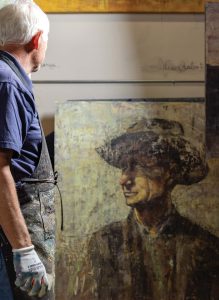
The artist’s large-scale works envelop viewers in emotion. In this painting, a farmer’s gaze seems to tell an entire story.
In his studio, a pair of blue and white vases holds bouquets of paintbrushes, but Spooner also works with palette knives, chisels, and sandpaper, as well as his hands. His paintings stand out as provocatively unusual, and he holds a proprietary interest, understandably protective of his process. He demurs when people inquire about the specifics of that process.
“It’s all fairy winks,” he says.
Fairy winks and elbow grease, perhaps. For his large works, Spooner often lays down 15 to 20 layers and works through as many iterations of each painting.
“It’s constructive and destructive,” he says. “I go through many variations. The end is unknown. I think of it as excavating a painting.”
Now, at age 68, Spooner himself remains a work in process. As he puts it, “I’m not afraid to evolve.”
Colleen Smith is an award-winning author, journalist, filmmaker, and graphic art director based in Denver, Colorado. She writes about fine art, popular culture, and the American West for dozens of magazines, newspapers, and websites.
Based in Denver, Colorado, Kristopher Lewis has been a professional photographer for more than a decade. He specializes in wedding, portrait, architectural, and real estate photography; kristopherlewis.com / @klewispix.





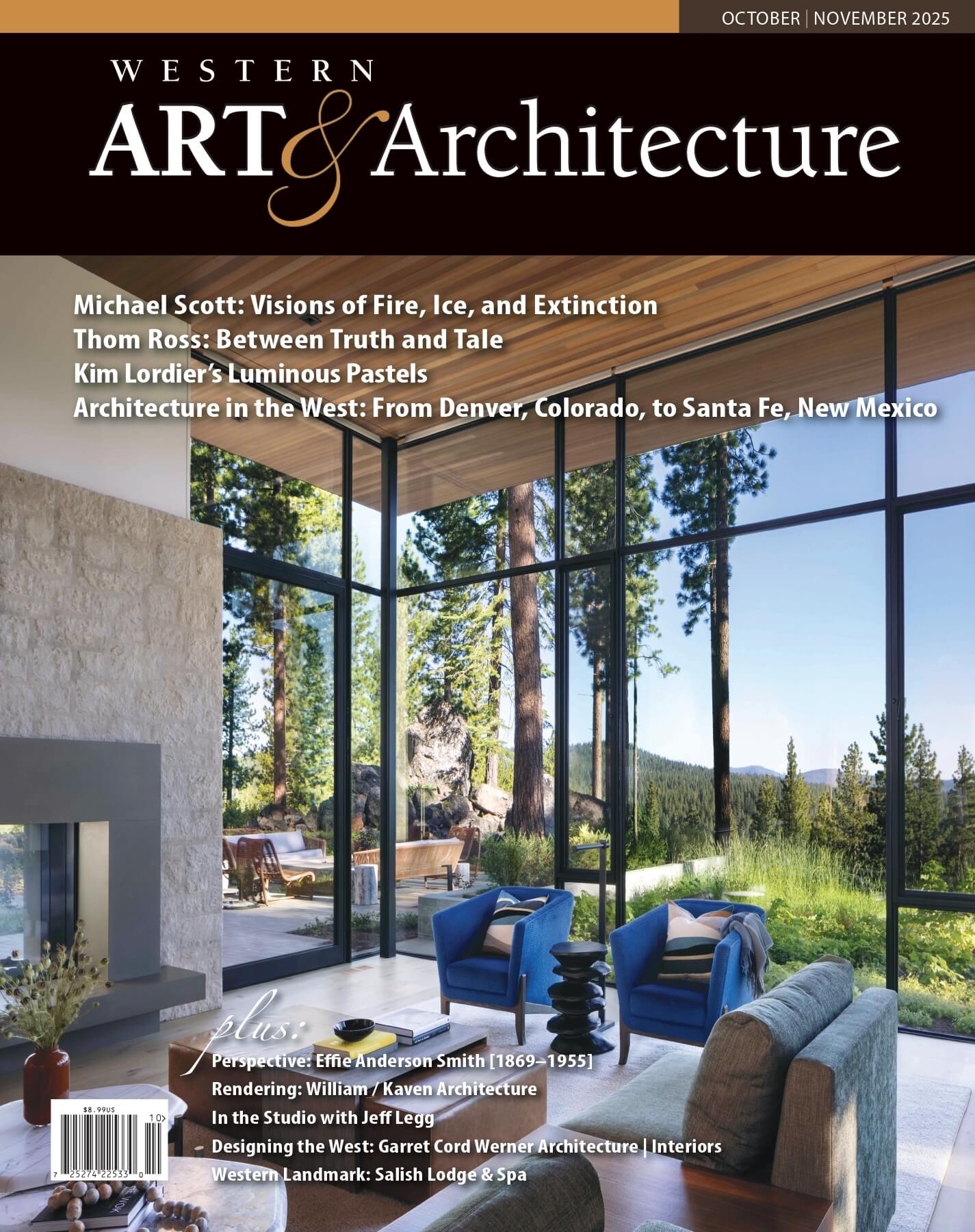
No Comments